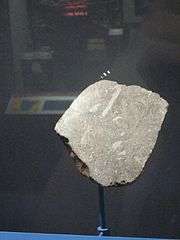Aubrite
| Aubrite | |
|---|---|
| — Group — | |
|
Cumberland Falls, an aubrite | |
| Type | Achondrite |
| Class | Asteroidal achondrite or enstatite achondrite |
| Parent body | Possibly (3103) Eger |
 Shallowater meteorite, an aubrite | |
Aubrites are a group of meteorites named for Aubres, a small achondrite meteorite that fell near Nyons, France, in 1836. They are primarily composed of the orthopyroxene enstatite, and are often called enstatite achondrites. Their igneous origin separates them from primitive enstatite achondrites and means they originated in an asteroid.
Aubrites are typically light-colored, and with a brownish fusion crust. Most aubrites are heavily brecciated. It's often said that they look "lunar" in origin.
Aubrites are primarily composed of large white crystals of the Fe-poor, Mg-rich orthopyroxene, or enstatite. Around this matrix, they have minor phases of olivine, nickel-iron metal, troilite, which indicate a magmatic formation under extremely reducing conditions. The severe brecciation of most aubrites attests to a violent history for their parent body. Since some aubrites contain chondritic xenoliths it is likely that the aubrite parent body collided with an asteroid of “F-chondritic” composition.
Comparisons of aubrite spectra to the spectra of asteroids have revealed striking similarities between the aubrite group and the E-type asteroids of the Nysa family. A small Near-Earth object, (3103) Eger, is also often suggested as the parent body of the aubrites.
See also
| Wikimedia Commons has media related to Aubrites. |
External links
- http://www.daviddarling.info/encyclopedia/A/aubrite.html
- http://www.lpi.usra.edu/meetings/lpsc2004/pdf/1812.pdf
- http://www.uni-muenster.de/imperia/md/content/planetologie/pdf/bischoff/mess_ii_endversion.pdf
